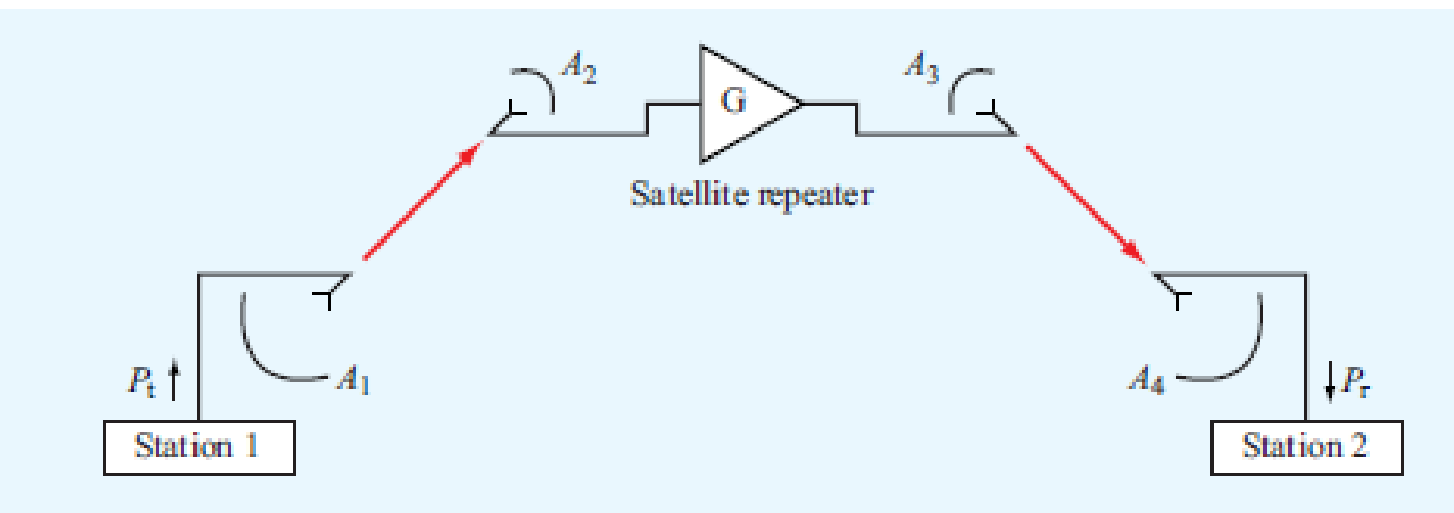
Concept explainers
The configuration shown in Fig. P9.29 depicts a satellite repeater with two antennas, one pointed towards the antenna of ground station 1 and the other towards the antenna of ground station 2. All antennas are parabolic dishes, antennas A1 and A4 are each 4 m in diameter, antennas A2 and A3 are each 2 m in diameter, and the distance between the satellite and each of the ground stations is 40,000 km. Upon receiving the signal by its antenna A2, the satellite transponder boosts the power gain by 80 dB and then retransmits the signal to A4. The system operates at 10 GHz with Pt = 1 kW. Determine the received power Pr. Assume all antennas to be lossless.

Figure P9.29 Satellite repeater system.
Want to see the full answer?
Check out a sample textbook solution
Chapter 9 Solutions
Fundamentals of Applied Electromagnetics (7th Edition)
- Here the Req is 8 my prof solved it and got R3 is parallel to R4 in series with R2 and this combination is parallel to R1. i don't understand how he got these relationships. initially i did the opposite i took (R1//R4 + R2 ) + R3 but got the wrong answer why is it wrong? can you explain to me if there's a trick i can do to understand these questions better and know the configurations of the resistors in a better manner?arrow_forwardHere the Req is 8 my prof solved it and got R3 is parallel to R4 in series with R2 and this combination is parallel to R1. i don't understand how he got these relationships. initially i did the opposite i took (R1//R4 + R2 ) + R3 but got the wrong answer why is it wrong? can you explain to me if there's a trick i can do to understand these questions better and know the configurations of the resistors in a better manner?arrow_forwardThe ROC of Laplace transform of x(t) = -e²u(t) + e02tu(t) + e.tu(t) is a) 0.1 0.2arrow_forward
- A left-sided signal x(t)=-e¯bt u(-t): 0 == X(s) -e-bu(t)e-st dt =- -Le-c 1 -(b+o+jw)t dt = = -00 -∞ (a + b) + jw 1 s+b For this integral to converge, it is necessary that b +σ <0; i.e., ROC: Re[s]=σ < −b. 2 How ?arrow_forwardA left-sided signal x(t)=-ebt u(-t): A right-sided signal x(t)=e¯at u(t) Find Laplace transform of x(t)=u(t)arrow_forwardFind Laplace transform of x(t) = −e¯btu(−t) + e¯atu(t) Find Laplace transform of x(t) = u(t)arrow_forward
 Introductory Circuit Analysis (13th Edition)Electrical EngineeringISBN:9780133923605Author:Robert L. BoylestadPublisher:PEARSON
Introductory Circuit Analysis (13th Edition)Electrical EngineeringISBN:9780133923605Author:Robert L. BoylestadPublisher:PEARSON Delmar's Standard Textbook Of ElectricityElectrical EngineeringISBN:9781337900348Author:Stephen L. HermanPublisher:Cengage Learning
Delmar's Standard Textbook Of ElectricityElectrical EngineeringISBN:9781337900348Author:Stephen L. HermanPublisher:Cengage Learning Programmable Logic ControllersElectrical EngineeringISBN:9780073373843Author:Frank D. PetruzellaPublisher:McGraw-Hill Education
Programmable Logic ControllersElectrical EngineeringISBN:9780073373843Author:Frank D. PetruzellaPublisher:McGraw-Hill Education Fundamentals of Electric CircuitsElectrical EngineeringISBN:9780078028229Author:Charles K Alexander, Matthew SadikuPublisher:McGraw-Hill Education
Fundamentals of Electric CircuitsElectrical EngineeringISBN:9780078028229Author:Charles K Alexander, Matthew SadikuPublisher:McGraw-Hill Education Electric Circuits. (11th Edition)Electrical EngineeringISBN:9780134746968Author:James W. Nilsson, Susan RiedelPublisher:PEARSON
Electric Circuits. (11th Edition)Electrical EngineeringISBN:9780134746968Author:James W. Nilsson, Susan RiedelPublisher:PEARSON Engineering ElectromagneticsElectrical EngineeringISBN:9780078028151Author:Hayt, William H. (william Hart), Jr, BUCK, John A.Publisher:Mcgraw-hill Education,
Engineering ElectromagneticsElectrical EngineeringISBN:9780078028151Author:Hayt, William H. (william Hart), Jr, BUCK, John A.Publisher:Mcgraw-hill Education,





